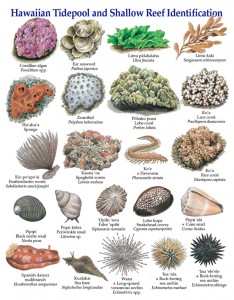

While conditions in the intertidal zone can be extreme, it is home to many living things and is also an important feeding spot for both resident and migrating birds. The low tide zone is only exposed during low tide and has the greatest biodiversity of the three zones because it provides more favorable conditions for those organisms that cannot tolerate air exposure for long. The middle tide zone is submerged and exposed for equal amounts of time. The high tide zone is only submerged at high tide and is hotter and drier as a result. The intertidal zone can be further divided into three zones: high tide, middle tide, and low tide. The presence of predators and species that compete for the same space and food also impact where an organism will be found. Where a species lives within the intertidal zone depends on its tolerance of underwater and above-water conditions. Sandy shores provide sediments in which organisms bury themselves to stay cool and moist during low tide. Organisms that cannot normally survive low tide conditions, like sea stars, shrimp, or fish, can take refuge in these pools. Intertidal zones richer in sediments are filled with different species of clams, sand dollars, and worms.Īt rocky shorelines, tide pools can form in holes, cracks, or crevices where seawater collects as the tide goes out. Barnacles and mussels can also hold seawater in their closed shells to keep from drying out during low tide. Barnacles, mussels, and kelps can survive in this environment by anchoring themselves to the rocks. Intertidal zones of rocky shorelines host sea stars, snails, seaweed, algae, and crabs. Anything living in the intertidal zone must be able to survive changes in moisture, temperature, and salinity and withstand strong waves. Some species live further up the shore and closer to the high tide line, while others live further down the shore, closer the low tide line. Organisms that live in the intertidal zone tend to form their own communities across the zone’s elevation gradient. This ecosystem is rife with research opportunities for marine researchers like National Geographic grantee Swapnale Gole, who studies the behavior of sea anemones, crustaceans, and fish in the intertidal zones of the Andaman Islands in India. The zone is completely submerged by the tide once or twice every day. Certainly bacterial counts can rise and fall due to a number of causes, triggered primarily by the presence of humans. As a result, these changes in bacterial counts will be inversely related to the abundance of tidal pool marine life. The intertidal zone experiences two different states: one at low tide when it is exposed to the air and the other at high tide when it is submerged in seawater. I further predict that as bacterial counts decline, tidal pool marine life will increase.

It is located on marine coastlines, including rocky shores and sandy beaches. The intertidal zone is an extreme ecosystem because it constantly experiences drastic changes.


 0 kommentar(er)
0 kommentar(er)
